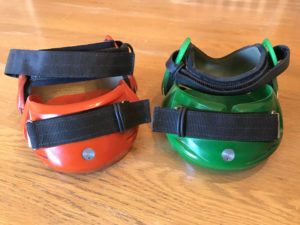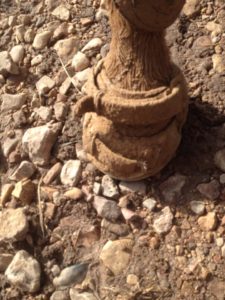
One question we often get, or comments we will see, relates to our fastening system and the hook and loop straps. A number of years of testing of different fastening mechanisms went into the development of the Renegades, and ultimately, the hook and loop strapping won out over options such as buckles, clips, clamps, or other mechanisms.
There are several reasons why we choose, and still continue to use, hook and loop straps:
– They offer the most options for adjustment. A solid strap (such as a biothane or nylon dog collar) only has the option of being adjusted where holes are punched into the solid material, which means the possibility of a hole either being placed a little too short or a little too long. With hook and loop material, the adjustment can be dialed in very precisely, allowing for a great deal of flexibility during a trim cycle, without having to do in and do full-scale cable adjustments.
– We have continually upgraded the strap materials over the years, experimenting with different grades and degrees of grip and hold. The hook and loop material we are currently using (and have been using for the last seven years), is a marine-grade material, designed to be used in wet, sandy, muddy conditions.
– They are easy to replace. The design is such that it is easy to remove and replace worn out straps. We have also ensured that it is cost-effective to do so. Production and manufacturing of the straps is such that we are able to keep the cost of the straps down.
– They are low profile and will not catch on terrain or debris. The front of the boot does not have any protruding buckles, hardware, or fastening mechanisms that can be damaged or cause the horse to catch on something (or cause interference wounds from hind to front if used on the hind hooves). Most hardware is very susceptible to impact damage, and it is easy to deform, distort, or outright break many metal buckles and fasteners.
-Additionally, the hoop and loop material backed by nylon strapping will not stretch — too flexible of strapping materials will stretch and move with the horse’s movement, but they can also keep stretching, to the point where it may not maintain an effective hold on the boot.

It is true that hook and loop material can have its downsides – it does have a finite lifespan, especially in wet, muddy, or sandy conditions, or in areas of dry grass. To extend the lifespan of the straps, there are a few things you can do:
– Wash the boots after they’re exposed to strap-wearing conditions. Rinsing them under a hose or in a bucket, and washing dirt off the straps before it dries, is the best way to extend the life of the material. Note: Do not use a wire brush or too stiff of a brush to scrub the straps; it will catch and damage the hook and loop material. If you have extreme levels of mud to remove from them, the best way to clean the straps is to remove them from the boots and let them soak in water first, then rinse them under running water, using a soft brush as necessary.
– When installing the boots, make sure the hoop and loop material makes good contact with itself. Fasten the strap, then go back and press your thumb or fingers over the top of the strap, really “squishing” the two halves securely together. The tighter of a hold the two halves have on each other, the less likely it is debris will be able to get in-between the straps.
– For extra security and hold in rough conditions, install extra rubber keeper loops along the straps. This may make it more “involved” to install the straps, but it would be recommended for extra peace of mind in rough conditions, especially if straps are starting to get worn or lose their holding power. Zip ties also would work, although they are one-time use.
– In extreme cases (such as dry grasses), you can lay a layer of vetwrap under the strap, with enough sticking out on the top and bottom to cover the strap. Fasten the strap as normal, then fold the vetwrap pieces over the strap and onto themselves.
Finally, we do send a spare tension strap with every boot ordered. Don’t let them sit around gathering barn dust – when those straps start wearing out, pull out those spares and replace them, especially before an event or significant ride. We recommend checking your boots before any sort of event and replacing worn parts as necessary for the best chance of boot success.
